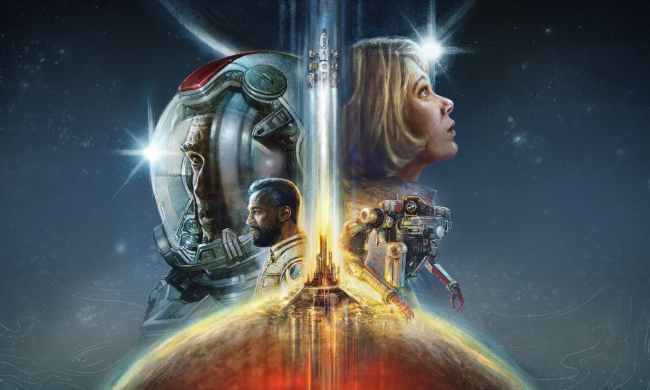We got a ton of details on Marvel’s Guardians of the Galaxy at Square Enix’s E3 showcase. The game got a massive spotlight, taking up half of the livestream’s run time. There were insights from the team behind it, a trailer, and a full gameplay demo — the whole kit and caboodle.
Even with all those details, there was still no shortage of questions about how the single-player game works. The demo gave a sweeping overview of everything from its dialogue choices to combat, but there are lots of little systems to dig into.
In a roundtable interview, Senior Producer Olivier Proulx and Senior Gameplay Director Patrick Fortier went into greater depth about how its squad-controlling system works. They revealed some previously unrevealed features, too, such as crafting and huddle systems.
Solo team play
Perhaps the most surprising detail about Marvel’s Guardians of the Galaxy is that it’s a single-player game. Players only control Star-Lord directly and issue commands to teammates a la Mass Effect. Considering the team-based nature of the franchise, that might seem head-scratching at first.
While there were some early debates about how the game should work, the choice to make it a single-player experience was decided very early on. The game features “solo team play,” which drives home the teamwork theme in a way that’s much different than a multiplayer title, according to Patrick Fortier.
“If we embody Peter, then we can experience teamwork from a different point of view,” says Fortier “In real life when you’re part of a team, you don’t control the team. You have to negotiate with your team. Those dynamics felt like we could explore that if we made this more of a single-player game. But it ultimately feels like an ensemble thing, because the Guardians are present in every single thing.”

As for how controlling the team works, Fortier explains that players have a dedicated Guardians button. Pressing it opens up an overlay where players can select a character and then an ability via the face buttons (Star-Lord has his own ability menu too). Each character has a different independent cooldown timer, so players have to manage when they call people in. Each character also has their own specialty too.
“Rocket is our ranged guy. He can shoot enemies that are higher and further,” says Fortier. “Groot is more defensive. He can immobilize characters and push them back. Drax is a brawler who takes on many enemies, sometimes too many. He does stagger damage, which you need to do sometimes before you can start depleting the health bar of certain enemies. And then Gamora is the closer; she does the single most damage on an enemy with her blade.”

The most fun teamwork mechanic is the game’s Huddle system. As players fight, they raise a momentum gauge. Hitting a button allows players to spend momentum to trigger a football huddle with the team in battle. Star-Lord can essentially give the team a morale boost
“Peter draws from his encyclopedic knowledge of songs from the ’80s and creates a motivational speech out of that,” says Fortier. “That’s what you’re choosing as a player: Which speech is going to motivate the team in the context of this fight right now? As you make the choice, you hit play and a song will start playing.”
Star-Lord will always get a boost after huddles because, well, he believes in his own speeches. But the rest of the team might not be as easily swayed. They’ll still get basic benefits, like being revived if they’re downed, but only a good speech will give them a full boost. It’s a hilarious little detail that drives home the single-player teamwork idea that flows through the game.
Crafting, skills, and Rickrolls
The developers shared several new details on other systems. For one, the game has a simple crafting system, which grants Star-Lord certain perks. Players can find crafting parts throughout the world and take them to a workbench to craft parts, according to Olivier Proulx.
“You have little perks and bonuses for Star-Lord’s visor, his armor, his jet boots, his blasters,” says Proulx. “He can also unlock elements for his blasters. As you move through the adventure, he has four elements, and they can be used creatively in combat.”

While the game does have a few added systems, Fortier emphasizes that the team didn’t want to overcomplicate things or get in the story’s way with mechanics. As a result, it features some simplified systems that focus on ability unlocks instead of loot, gear, and RPG number-raising.
“It has very light RPG aspects like other games,” says Fortier. “As you perform well in combat, we have this momentum gauge. At the end of the combat you get rated, and you get points for that. With those points, you can unlock new abilities for the Guardians. You can upgrade whichever Guardian you want.”
The most important revelation? The game features 31 songs in total from various ’80s titans. And yes, that includes Rick Astley, so prepare to be Rickrolled. While tunes will mostly play during battle through the huddle system, Proulx confirms that there’s a jukebox in the Guardians’ ship, the Milano, where players can just hang out with the squad and listen to jams.
Judging by all those details, Marvel’s Guardians of the Galaxy is shaping up to be a unique single-player game that’s true to the spirit of the comics and movies. It sounds entirely different from other Marvel games like Spider-Man or Square Enix’s live-service Avengers game, which makes sense. The Guardians of the Galaxy are unlike any Marvel heroes out there, so why should their game be any different?
Marvel’s Guardians of the Galaxy launches on October 26 on PS4, PS5, Xbox One, Xbox Series X/S, and PC.



